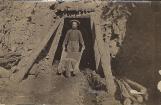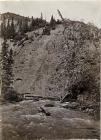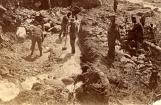15
Hand-made WheelbarrowMost of the goldfields were in remote areas and transportation of goods arduous. The rugged gold miner was a "jack-of-all-trades" who learned to improvise and make what he needed from available materials.
17
StockpilePay gravels were stockpiled near the creek until there was a considerable pile ("dump") . Several days diggings could usually be sluiced in a day.
19
Dams and DiversionsWhen sluicing beside a river or large creek a few trees could be used to divert enough water. With a smaller creek, the entire flow would be dammed and directed with a ditch to the sluicebox.
21
SluicingAll hands in use - shovelling into the sluicebox, shovelling the "tailings" away from the end, and controlling the flow of water. Tailings or "tails" are the waste materials.
Substantial water to a depth of 3-4 inches above the riffles is needed to create undercurrents. The box was tilted at a "drop" of around 4 inches to the foot of length.
23
Panning the ConcentratePlacer gold mining starts with test panning. It ends with the panning of the concentrate of heavy materials from the bottom of the sluicebox. The final cleanup involves panning to separate the gold from iron pyrites
(fool's gold), black sand (magnetite) and the other heavy compounds.
25
Icon of the Yukon, Part 2The silhouette of the solitary gold panner adorns the Yukon license plate to this day.





